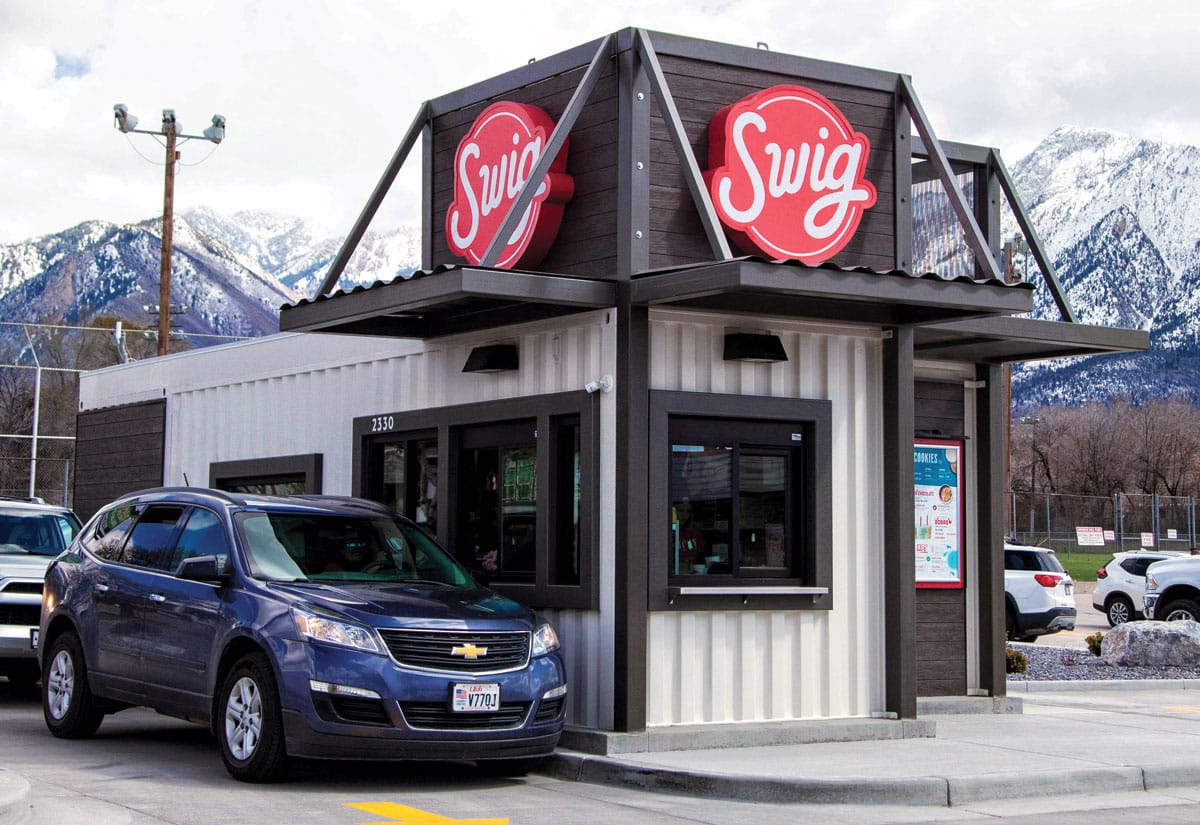The volatile post-pandemic indoor dining experience is forcing operators to look for workarounds to the risks associated with dining rooms, and in many ways to explore new footprint opportunities that minimize the dining room altogether.
One real estate option that could take off in the wake of all this? The shipping container. While these rectangular boxes have been a part of the foodservice industry for years, they’re becoming especially attractive as operators rethink their real estate size and try to do more with less.
Chip Colonna, the vice president of national accounts for container company PODS, noticed restaurant clients shift their usage of PODS units when dining rooms closed in March. Clients usually used the product for excess inventory, but one restaurant cut a hole in the front end of the container, effectively making a drive-thru window.
“Now [the restaurant] has that container part in the parking lot, so they’re loading through the back all the meals for the customers that have called in and placed orders,” Colonna says. “But when the customer drives up, they’re able to hand the meal through the window that’s cut into the back side of the container, as opposed to having that customer come into the restaurant.”
Colonna says the client was the only one who has used the container in this new way, but he anticipates new uses of the PODS container in the future. Even during the pandemic, the U.S. military requested that the company make containers fit for COVID patient isolation, which has brought new product considerations—from electricity to air conditioning—to the company.
“It’s not just leasing a container for a month at $200,” Colonna says. “What other things can we do as a company to make sure that we’re staying ahead of the curve in anticipating what those customers are going to need?”
Other brands in the restaurant industry are trying to stay ahead of the curve with shipping-container units. Michigan-based coffee brand Biggby Coffee designed a modular drive thru with the containers before the pandemic and started rolling them out after COVID hit. The shipping-container units are loaded onto two semi-trucks and shipped to the site.
“There’s a crane there, it lifts [the parts] off, they bolt them down, they turn the electricity on, and they’re serving coffee within 48 hours,” says Mike McFall, co-CEO of Biggby Coffee.
McFall says the brand is going to prioritize the drive-thru units, especially since drive thrus have helped some companies get through the pandemic relatively unscathed.
“Some of these drive thrus—even the drive thrus that have lobbies—they’re doing so much business, they can hardly keep up right now. You can’t ignore that,” McFall says.
Utah-based soda chain Swig also noticed the push for drive thru before the pandemic.
“Right now, especially with COVID, every restaurant wants a drive thru. We’re seeing full-scale restaurants shut down lobbies and create drive thrus in their parking lots,” says Chase Wardrop, president of Swig. “But about a year and a half ago, we knew we had to figure out a different model, because the drive-thru space was so competitive.”
The brand set out to make its own miniature footprint as an alternative to fighting for an end-cap space. Swig took unlikely inspiration from shaved-ice shacks that appeared in Utah during the summer, and made adjustments for full-time occupants.
Swig looked at other instances of value-engineered space, like tiny homes and other businesses using the shipping container, to inform its design. To ensure that the company efficiently utilized every square foot of space, Wardrop and his partner, Dylan Roeder, created a scaled model of a shipping container with cardboard boxes.
“We put everything to the height, to the scale, and we just laid it out for hours, and we dialed in every foot of that container,” Wardrop says. “We knew we had to get down to 500 square feet or else it would be too big to be put into parking lots.”
Swig had to make considerations on other aspects of the building as well, like the feeling of spaciousness, in order to make the shipping container a comfortable working environment. In the end, Swig engineered a set-up consisting of three shipping containers cut in half and welded together to become an actual building. Each container-based unit is set to handle seven or eight employees. To practice proper sanitation, each Swig container has an iPad alarm that alerts employees to wipe down the store every half hour.
The advantages of the shipping containers go beyond its efficiency, opening the door for potential partnerships, too. Because of its smaller stores, Swig started a relationship with grocery brand Kroger to put the new Swig buildings in the parking lots in front of the grocery stores.
“With the added business we bring for [Kroger], to give up four parking stalls is pretty tremendous. People are starting to recognize that and wanting to partner with us because of it,” Wardrop says.
However, this novel idea isn’t without its drawbacks. One of the biggest problems is setting up the container’s utilities in a space where it isn’t readily available. And the novelty of containers confuses cities, where officials aren’t sure how to categorize them from a code standpoint.
As Swig plans to venture into four more states within the next 18 months, Wardrop says, it’ll build shipping containers wherever it can. “Pre-pandemic, this was our all-in strategy. This is how we’re going to grow,” Wardrop says. “We’re letting everything ride on this strategy, and so far it’s panned out really well.”












